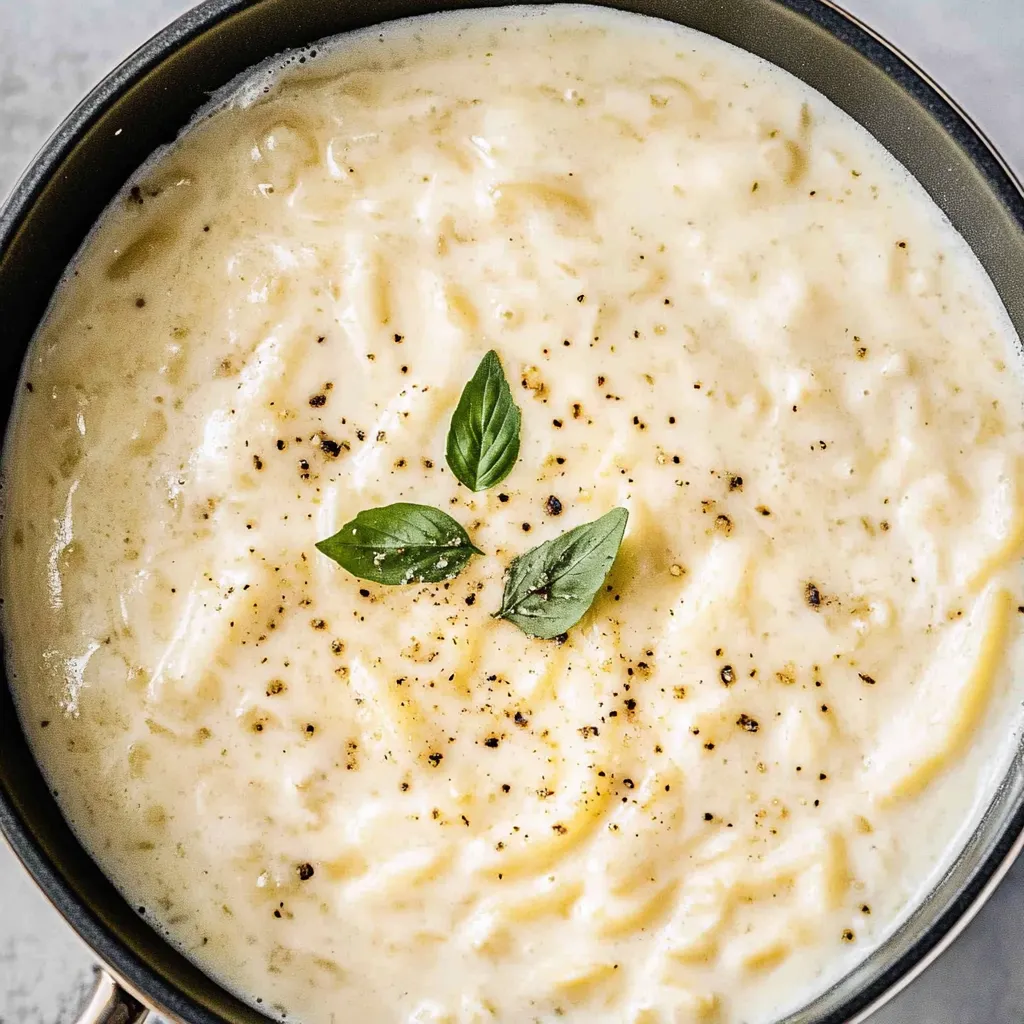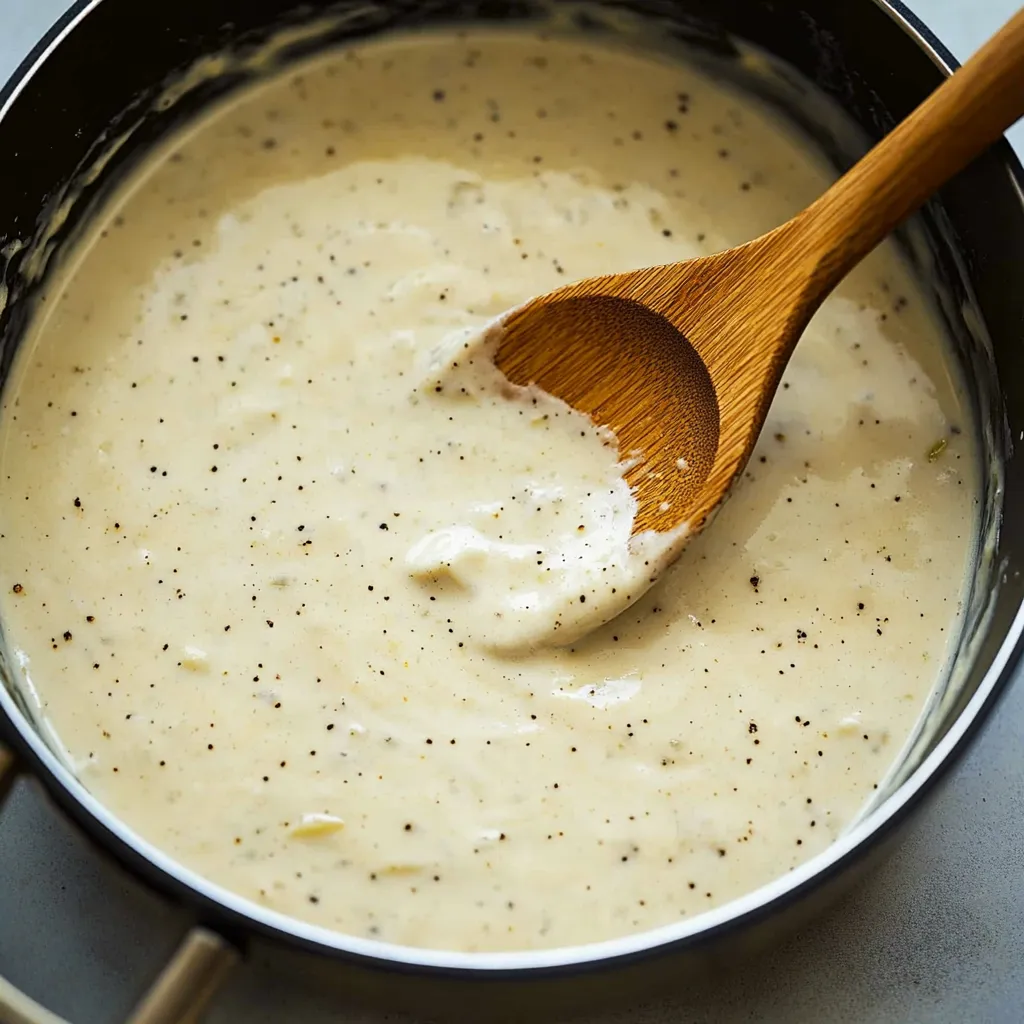 Pin it
Pin it
This incredibly rich, restaurant-quality alfredo sauce transforms ordinary pasta into something absolutely luxurious using a secret ingredient that takes it far beyond traditional versions. The addition of cream cheese creates the most velvety, tangy depth that you simply cannot achieve with just butter, cream, and Parmesan alone, while the careful technique ensures a silky smooth sauce that never breaks or becomes grainy. Unlike complicated sauce recipes that require precise timing and advanced techniques, this foolproof method delivers consistently perfect results that taste like you've been cooking Italian food for decades.
I discovered this recipe when I was trying to recreate my favorite restaurant's alfredo sauce and couldn't understand why mine never tasted quite right. The moment I added cream cheese to the mix, everything changed - suddenly I had that perfect balance of richness and tang that makes alfredo sauce so addictive. Now my family requests this sauce constantly because they say it's better than any restaurant version they've tried.
Essential Ingredients and Selection Tips
- Heavy cream: Use real heavy whipping cream with at least 35% fat content; lighter creams won't create the proper richness or texture
- Cream cheese: Full-fat, room temperature cream cheese is essential; low-fat versions won't provide the same creamy texture or tangy depth
- Fresh Parmesan cheese: Grate it yourself from a block; pre-grated cheese contains anti-caking agents that make the sauce grainy and clumpy
- Real butter: Use unsalted butter so you control the salt level; margarine won't provide the same rich flavor or proper emulsification
- Fresh garlic: Minced fresh garlic provides much better flavor than pre-minced varieties; use plump, firm cloves without green shoots
- Quality seasonings: Fresh Italian seasoning blend and freshly ground black pepper make a noticeable difference in the final flavor
The secret to perfect alfredo sauce is maintaining gentle heat throughout the process and adding the Parmesan cheese off the heat to prevent it from seizing up or becoming stringy.
Detailed Step-by-Step Instructions
- Step 1: Prepare your ingredients:
- Grate the Parmesan cheese fresh from a block and set aside. Soften the cream cheese to room temperature by leaving it out for about 30 minutes, or cut it into small cubes for faster melting. Have all seasonings measured and ready since the sauce comes together quickly.
- Step 2: Create the cream base:
- In a medium saucepan over medium heat, add the butter, heavy cream, and cream cheese. Whisk continuously as everything melts together, ensuring the cream cheese incorporates smoothly without forming lumps. This should take about 3-4 minutes.
- Step 3: Add aromatics:
- Once the base is smooth and creamy, add the minced garlic, garlic powder, Italian seasoning, salt, and pepper. Continue whisking for another minute until the garlic becomes fragrant and all seasonings are well distributed throughout the sauce.
- Step 4: Remove from heat for cheese:
- This is the critical step - remove the pan from heat completely before adding the Parmesan cheese. The residual heat will melt the cheese perfectly without causing it to seize up or become stringy, which happens when cheese is added to actively cooking sauce.
- Step 5: Incorporate cheese gradually:
- Add the freshly grated Parmesan in small handfuls while whisking constantly. Wait for each addition to melt completely before adding more. This gradual process ensures smooth incorporation and prevents clumping.
- Step 6: Return to gentle heat:
- Once all cheese is incorporated and the sauce is smooth, return the pan to low heat. Whisk gently for 2-3 minutes until the sauce thickens to coat the back of a spoon. Never let it boil, as this can cause the sauce to break.
- Step 7: Check consistency:
- The finished sauce should be thick enough to coat pasta but thin enough to pour easily. If it's too thick, whisk in a tablespoon of warm cream; if too thin, simmer gently for another minute or two while whisking.
- Step 8: Taste and adjust:
- Sample the sauce and adjust seasoning with additional salt, pepper, or garlic powder as needed. The flavor should be rich and balanced with noticeable Parmesan and garlic notes complemented by the cream cheese tang.
- Step 9: Serve immediately:
- Alfredo sauce is best served hot and fresh. Toss immediately with hot pasta, adding a splash of pasta cooking water if needed to help the sauce coat the noodles perfectly.
 Pin it
Pin it
The most important technique is whisking constantly and managing heat carefully - too high heat will cause the dairy to break, while insufficient whisking can result in lumpy, separated sauce.
This alfredo sauce has become the recipe I'm most proud of because it proves that understanding the science behind cooking can elevate simple ingredients into something truly exceptional. My neighbor, who considers herself a serious Italian cook, admitted this sauce is better than her grandmother's recipe, which I consider the ultimate compliment.
Understanding Dairy Science and Emulsification
Creating perfect alfredo sauce requires understanding how different dairy products behave when heated and combined. Heavy cream provides fat globules that create richness, while butter contributes both fat and water that help create a stable emulsion. Cream cheese adds both tanginess from bacterial cultures and additional proteins that help stabilize the sauce. The key is maintaining gentle heat that allows these components to combine smoothly without causing protein coagulation that leads to curdling or separation.
Cheese Integration and Temperature Control
Parmesan cheese contains proteins that can seize and become stringy when exposed to high heat, which is why adding it off the heat is crucial. The residual heat from the cream base is sufficient to melt the cheese while the gentle temperature prevents protein damage. Fresh-grated cheese melts more smoothly than pre-grated varieties because it hasn't been treated with anti-caking agents that interfere with melting. Understanding these principles ensures consistently smooth results.
Sauce Consistency and Thickening Mechanisms
Alfredo sauce thickens through several mechanisms: the natural proteins in dairy products, the starches released from cheese, and the reduction of liquid through gentle simmering. The cream cheese contributes additional thickness through its higher protein content, while the Parmesan adds both flavor and natural thickening power. The whisking action helps create a smooth, homogeneous mixture while preventing skin formation on the surface.
Flavor Balance and Seasoning Principles
The perfect alfredo sauce balances richness from dairy with umami from Parmesan, aromatic depth from garlic, and subtle tang from cream cheese. Italian seasoning adds herbaceous notes that prevent the sauce from being one-dimensional, while salt enhances all flavors and helps the cheese melt more smoothly. The proportions are carefully balanced so no single flavor dominates while creating a complex, satisfying taste profile.
Storage and Reheating Science
Dairy-based sauces like alfredo are prone to separation during storage and reheating because the fat and water components naturally want to separate over time. Gentle reheating with constant stirring helps re-emulsify the sauce, while adding small amounts of warm cream can restore the original consistency. Microwaving should be avoided because the rapid, uneven heating can cause permanent separation that's difficult to repair.
This alfredo sauce has taught me that sometimes the most impactful cooking improvements come from understanding why traditional techniques work and then finding ways to enhance them thoughtfully. Every time I make it, I'm reminded that great cooking is often about patience, gentle heat, and respecting the ingredients you're working with rather than trying to rush or force the process.
Frequently Asked Questions
- → Can I use milk instead of heavy cream?
- Heavy cream works best for the thick, rich texture. Milk will make a thinner sauce that may not coat pasta well.
- → How long does homemade Alfredo sauce last?
- Store it in the fridge for up to 3 days. Reheat gently on low heat and add a splash of cream if it gets too thick.
- → Why is my Alfredo sauce lumpy?
- This usually happens when the heat is too high or the cheese is added too quickly. Keep heat at medium and add cheese gradually while whisking.
- → Can I freeze Alfredo sauce?
- Cream-based sauces don't freeze well as they tend to separate. It's best to make fresh batches as needed.
- → What pasta works best with Alfredo sauce?
- Fettuccine is classic, but any pasta shape works. Try penne, rigatoni, or even gnocchi for variety.
- → Do I need to use fresh Parmesan cheese?
- Fresh grated Parmesan melts much better than pre-grated. It creates a smoother sauce without the grittiness.
